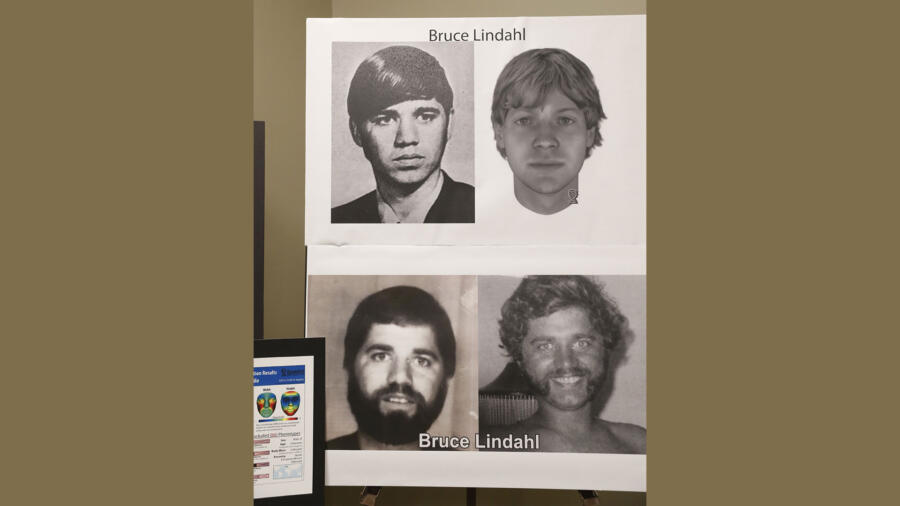A 45-Year Mystery Begins
In March 1979, Kathy Halle—a bright-eyed 19-year-old—stepped out of her North Aurora apartment for what should have been a routine errand. Her family expected her back that evening. She never returned.
The next day, her car was found parked where she’d left it, but blood stained the back mat. A month later, a young boy discovered Kathy’s body floating in the Fox River. Her white ski jacket was still wrapped around her. The mystery began.
The Night She Vanished
On March 29, 1979, under heavy clouds and slick roads, Kathy drove out to pick up her sister from work at Northgate Shopping Center. She was kind, reliable, and had plans for the future. But something happened during that drive. Something evil.
When police found her car, it offered few answers—just blood and silence. Detectives questioned friends and family, followed every lead, but the trail quickly went cold.
An Epidemic of Violence
Kathy wasn’t the only victim in the area during that time. Throughout the late ’70s and early ’80s, women in DuPage and Kane counties lived in fear.
- Pamela Maurer, age 16, was raped and strangled in 1976.
- Debra Colliander, 25, survived a brutal rape in 1980—only to vanish months later before she could testify.
The pattern was undeniable. A predator was stalking young women.
A Name in the Shadows: Bruce Lindahl
Bruce Lindahl blended in. To most, he was polite—even charming. But behind the facade, he was a serial rapist and killer.
In 1981, Lindahl attacked an 18-year-old man. During the struggle, Lindahl accidentally sliced his own femoral artery and bled to death. His victims never got justice. The truth, however, refused to stay buried.
A Glimmer of Hope Through DNA
Years later, advances in forensic science reopened old doors. DNA helped solve Pamela Maurer’s case—Lindahl had left his mark.
With renewed hope, North Aurora Detective Ryan Peat revisited Kathy’s file. Standard DNA tests on her clothing failed. Still, he refused to give up.
Then, in 2022, Peat attended a forensic seminar and learned about a revolutionary tool: the M-Vac DNA collection system.
What Is the M-Vac, and Why Was It Crucial?
Traditional swabbing methods often fail on porous fabrics. The M-Vac acts like a forensic vacuum, extracting trace amounts of DNA from deep within fabric fibers. It’s been a game-changer for cold cases, especially when evidence has degraded over decades.
A Personal Mission to Florida
Detectives Peat and a colleague didn’t trust anyone else with the evidence. In 2023, they personally flew Kathy’s preserved clothing to DNA Labs International in Florida, ensuring it arrived safe and intact.
It was, as Peat put it, “our Hail Mary.”
Breakthrough: A 9.4 Trillion-to-One Match
After meticulous processing, the results were undeniable. In August 2024, scientists matched the DNA to Bruce Lindahl with astronomical certainty—a 9.4 trillion-to-one likelihood.
For the first time in 45 years, they had their answer.
Justice, Even in Death
At a press conference on October 23, 2024, Kane County State’s Attorney Jamie Mosser confirmed what investigators long suspected: Bruce Lindahl killed Kathy Halle.
“He was a hunter,” Mosser said. “He waited, watched, and struck when the time was right.”
The Pain of Closure
Though Lindahl never faced a courtroom, Kathy’s family finally had clarity. Mosser met with them privately before the announcement.
“The hardest part,” she said, “is knowing they got to live full lives—have kids, build memories. Kathy didn’t. Her nieces and nephews never got to know her.”
Even closure carries grief.
A Serial Killer’s Unfinished Story
Authorities now believe Lindahl is responsible for more crimes—perhaps many more. With today’s forensic tools, detectives are hopeful they’ll bring answers to other families still waiting in silence.
“We won’t stop,” said Peat. “We owe it to every victim.”
Why This Case Matters
Kathy’s story reminds us that time doesn’t erase truth—it just buries it. For decades, silence surrounded her case. But science, dedication, and sheer willpower unearthed the answers her family deserved.
The Human Side of Science
This wasn’t just a technical triumph—it was a deeply personal mission. Investigators didn’t just follow protocols; they followed their hearts. They believed Kathy deserved justice, no matter how long it took.
And they were right.
FAQs
How did police finally solve the case?
They used the M-Vac DNA collection system on Kathy’s old clothing. The recovered DNA matched Bruce Lindahl with extremely high certainty.
Who was Bruce Lindahl?
Lindahl was a serial rapist and murderer active in Illinois during the late 1970s and early 1980s. He died in 1981 after a failed attack on a young man.
What is the M-Vac system?
A forensic tool that extracts trace DNA from porous materials like clothing, especially useful in cold cases with degraded evidence.
Why wasn’t Lindahl prosecuted?
Lindahl died in 1981. However, if alive today, he would have faced charges in multiple murder cases.
Are other cases linked to Lindahl?
Yes, authorities believe he may be tied to more unsolved murders and assaults from that era.
What happens now?
Investigators are reexamining similar unsolved crimes using DNA technology to bring justice to other families.
Conclusion: A Story That Deserved an Ending
For decades, Kathy Halle’s story went untold—just another cold case gathering dust. But today, her name stands as a testament to the power of science, persistence, and humanity.
Justice isn’t always swift. But it is possible—even after 45 years

